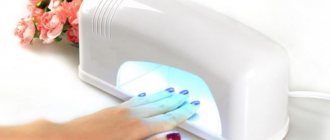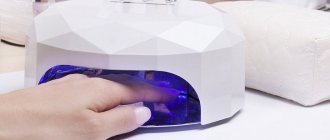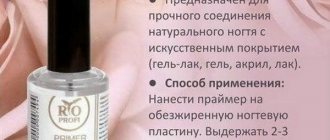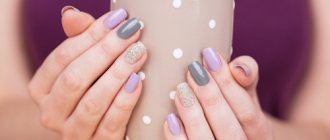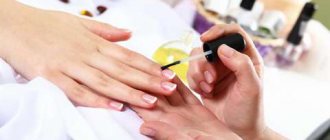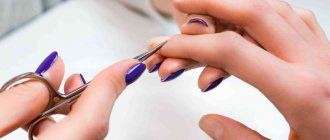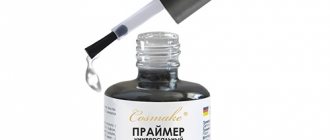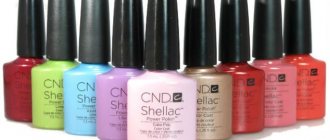Design and principle of operation of the lamp
Even a novice nail technician can use a lamp to dry gel polish. It must be remembered that there are several main types of this device. Each of them must be used depending on the selected material for work.
Today, there are three types of such lamps that work on a similar principle: ultraviolet lamp (UV), light-emitting diode (LED) and gas-light lamp (CCF). All 3 varieties differ in operation, although the principle itself remains similar. Each such lamp has its own advantages and disadvantages. A gas light bulb is most often found in conjunction with UV or LED and is, rather, an auxiliary technology for working with certain materials that require a separate special effect.
UV lamps
They were the very first to appear on the market and continue to be popular to this day. The main advantage is their power, which determines the rate at which the varnish hardens. A lamp may contain one or more lamps. Each bulb is 9 W. If there are two lamps, then the total power will be 18 W, etc. In the most powerful lamp, whose power is 36 W, the gel dries in 1-2 minutes.
On a note! In the case of professional UV lamps, it is possible to dry both hands at once, but such devices are not suitable for use at home. These lamps often have a timer that allows you to set the required time.
A significant disadvantage of UV lamps is the harmful effect they have on the human body. Ultraviolet radiation is harmful to human eyes and skin, and frequent use of the device can negatively affect nails.
How to dry your nails quickly
Manicure
by Julia Febber
19.09.2017
2433
0
I love getting my nails done, but sometimes, due to my impatience or when I think my manicure is completely done, I end up smudging it. And you have to sit for a long time and wave your arms. More precisely, I had to, until I found out several interesting ways to quickly dry my nails.
Method 1. In cold water
Place a handful of ice in a bowl of cold water. Make sure the cubes are large enough to not touch your nails. Prepare the water in advance so you don't have to deal with painted nails afterwards. After painting your nails with polish, simply dip your fingers in a bowl of water for about a minute.
You can paint your nails with one thick layer or several thin ones - one way or another, I don’t know why, but this method works. And when you take your hands out of the water, the nail polish is completely dry, it doesn’t smear or stick, it’s completely dry!
Method 2. Express drying
Another way to dry your nails faster is to use a special product. Nail dryer contains special substances that accelerate the evaporation of solvents contained in varnishes. A couple of drops - and in a minute the varnish will harden, after another five - it is completely dry.
Method 3. Food spray
A funny, yet effective method. The spray not only speeds up the drying process, but also moisturizes the skin of the hands and cuticles; you just need to rub in the liquid with massaging movements. Before work, do not forget to cover the table with a towel, and then wash your hands with soap.
Method 4. Hair dryer
You can also dry the varnish with a hairdryer. Nail salons use special hair dryers for drying, but regular hair dryers will also work. You just need to use it in cold mode, since hot air will only slow down the process. To avoid causing ripples and bubbles on the surface of the polish, do not hold the nozzle close to your nails.
Method 5. Quick-drying top
And finally, the most civilized, fastest and most obvious way to dry your nails is to purchase and use a quick-drying top coat.
(Following editor's note)
Is it possible to dry regular nail polish in an LED or UV lamp for gel polish?
No you can not. To “dry” gel polish, it must be treated with ultraviolet light under a UV or LED lamp. Simple nail polish dries in the usual way - by evaporating the solvents it contains (butyl acetate, ethyl acetate, etc.). You learned above how to speed up this process.
Is it possible to cover regular nail polish with a gel polish top coat and dry it in a lamp?
Yes, you can. However, before applying the top coat, make sure the nail polish is completely dry to avoid peeling. Read more about this here.
LED lamp
This type of lamp is more modern. Ultraviolet radiation comes from the LED. This technology allows the gel to harden in half a minute . Drying time is significantly reduced. The varnish is applied in a similar way, in three stages, between which drying takes place.
LEDs, unlike UV lamps, are practically harmless. In addition, they work much longer. The service life of such a lamp can reach 40-50 thousand hours.
Important! Unfortunately, the device is not capable of drying all materials. Some gel polishes are neutral to the effects of LEDs.
Dryers with this type of emitters are slightly more expensive than their UV counterparts. LED lamps, as a rule, cannot be replaced due to their durability. If the lamps burn out, the device is simply thrown away.
Main differences:
- UV uses a fluorescent light bulb, LED uses a light emitting diode;
- The UV lamp has a shorter lifespan and is harmful to the skin and eyes;
- LED does not work with all types of gel polishes;
- LED dries much faster;
- Low power UV units do not dry the gel properly.
Advice! Experienced users know that for optimal performance it is better to choose a hybrid device that contains both LED and UV technologies.
How to choose the best copy
When purchasing, you should pay attention to UV radiation with a certain wavelength. In today's market, the assortment is rich in its diversity and you need to know exactly what you want to buy. First, let's figure out how a nail extension lamp works.
A UV lamp allows the gel to crystallize in just a few minutes. The average exposure time of nail plates under the rays is 3-5 minutes. It is worth considering the fact that during hardening, heating occurs and this can cause some discomfort for any person. Warn your clients in advance about such inconveniences.
UV rays penetrate deep into the gels and after heating it, crystallization and hardening of the composition occurs. The gel doesn't just dry, it becomes hard from the inside. There is also a drying lamp, which is designed for acrylic nail extensions, which allows you to quickly dry the acrylic powder applied to the plates.
In the case of gel, such devices will not help, since the gel is initially a liquid material to work with, unlike acrylic, which can be diluted to the desired consistency. The gel can only be made to harden using UV lamps. There are several types of this equipment: with a timer, for one or two hands at once, with and without a retractable panel. It is also worth noting the difference in technical characteristics.
UV lamps for nail extensions vary in power and are a device that can operate both from the mains and from batteries. All lamps have the same range of UV radiation with a wavelength from 375 to 400 nanometers. Their power can be 9, 18, 36, 54 Vata. In order to professionally do nail extensions in a salon, the lamp must have a rated power of at least 36 watts.
Each device is equipped with a light bulb whose ultraviolet radiation power is approximately 0.85 W. The more powerful the device, the faster the polymerization process occurs. It is also worth noting that gels, French polishes and colored varnishes are different in their composition and some of them are quite difficult to dry with a 9-watt light bulb, so you should pay special attention to this aspect when choosing a UV lamp for nail extensions.
UV nail lamps are also available in various shapes on the market. In most cases, they are a semicircle with a reflective body.
If you decide to buy this device, and you simply need a nail extension lamp with ultraviolet radiation for work, then you should also pay attention to the following when choosing it:
- The appearance of the lamp should be neat and pleasant.
- The material from which the device is made must also correspond to the quality of the product.
- Check for a certificate of conformity and the presence of the “PCT” mark, which indicates that this lamp has been tested in Russia.
How to use a lamp at home
Modern models of lamps for drying gel polish are easy to use and do not require specific skills to use them. At home, operating the device will be no different from working in a nail salon. First of all, you need to carefully study the instructions included with each device. The first thing you should pay attention to is what kind of varnishes the model you have works with . Some lamps only work with certain types of materials, while others are universal.
Understanding the principle of the structure and operation of the device is not difficult. Most of the devices are made in a similar style, and resemble a miniature garage. On the top of the dryer there is a control, which is most often push-button. There are usually two buttons, but there may be more. If the device is hybrid, then on the case there will be an additional button for switching between lamp operating modes.
The lamp for drying gel polish works quite simply. The principle of operation comes down to pressing a button and holding your nails under the lighting. In some models equipped with sensors, there is no need to even press a button; the device turns on itself when the palm of your hand comes under the light source. If the device has a screen with a timer, then all you need to do is focus on it. However, if there is no timer, any stopwatch will do.
Important! You should not expose your nails to the lamp, or, conversely, remove your hand from the lighting ahead of time. The materials are very demanding in terms of strict adherence to time regulations. If you remove your nails earlier, the gel will dry unevenly.
Each coating manufacturer may have its own drying recommendations. Here are the average data for UV and LED lamps:
So, the main points of operation:
- know what materials the selected lamp model works with;
- read the instructions before use;
- observe timing, do not overexpose and do not remove nails ahead of time;
- take precautions.
During operation, the device may be damaged. In this case, it is necessary to place all damaged parts in a plastic (if possible sealed) container as soon as possible. To eliminate the undesirable consequences of caustic mercury vapor, you must contact a special service.
Which gel do you prefer?
What do you need to do nail extensions at home if you have no experience? It depends on the task at hand and the time you can expect with new plates.
The most popular nail extension products:
- Single phase base. It is the easiest to use, is considered ideal for beginners, and combines several functions. With it there is no need to use a base and fixer, although you need to first prepare the nail plate. Single-phase gel is applied in layers, evenly distributed over the surface. There are clear, matte and colored to complete the design.
- Biogel. Performs the same functions, differing in composition and consistency. It is produced from the resinous sap of the teak tree and has a liquid structure reminiscent of rubber. It is considered an environmentally friendly material. It is recommended for those who are interested in how to do nail extensions at home on hands corroded by chemical reagents. Biogel is enriched with liquid protein and calcium - this is an excellent basis for strengthening brittle plates.
- Camouflage gel. It has a thicker consistency, imparts naturalness to transparent tips and colorless forming coatings. It is good to increase the length of the build-up base for a French manicure and even out the tone, thanks to the pigment similar to the color of “naked” nails. White varnish completes the illusion of naturalness.
- Shellac. A universal product with the properties of different bases for extensions. Like other gel bases, it requires curing under a UV lamp (in a nail dryer). Lasts for at least 2 weeks, including a three-dimensional design on the surface with the overlay of stones, rhinestones, and other inclusions.
- Decorative or stained glass varnish. Used for original manicure design.
Attention! Before work, it is important to remove any remaining cuticle, followed by treatment with an antiseptic, degreaser, and primer. The hardened gel polish gives an impenetrable structure.
Neglect of simple requirements can provoke the development of fungus, reduce the quality of work, and lead to separation of tissues under the artificial nail.
Is there any harm from a nail lamp?
Many women wonder whether a nail drying lamp is harmful. Often, concerns can discourage a user from purchasing a dryer or visiting a nail salon. Fears for your health are far from unfounded. The question arose when the story of two women who were diagnosed with skin cancer was widely publicized. They both used UV nail dryers frequently. However, in a subsequent study of a larger sample of patients, no such deviations were identified. From which we can conclude that the occurrence of such diseases can be attributed to a special case and characteristics of the body, and not to the potentially harmful effects of UV rays.
Some experts continue to argue that even more intense exposure to UV rays on human skin and eyes is completely safe, and in some cases even beneficial. Of course, even with a minimal probability of developing terrible diseases, some people will experience justified fears.
To minimize negative consequences, doctors recommend using a dryer at a certain interval: do not change the nail polish more than once a week. This intensity can be hazardous to nail health, regardless of the potential harmful nature of UV exposure. On average, a well-made varnish coating lasts from two to three weeks. Even if you dry your hair 1-2 times a month, you most likely won’t have any serious consequences.
On a note! Some salons have recently offered special gloves that protect the skin from direct UV rays.
What you need to know about the dangers of using nail dryers:
- Frequent use of any procedure can harm the body;
- fixed time and local exposure to a small area of skin minimizes possible harmful effects;
- the harm from a lamp for drying nails has not been proven, but is only a hypothesis, the correctness of which everyone assesses for himself;
- if you maintain a certain interval and do not overexpose your nails under the dryer, and also use special gloves, the harm from exposure to UV rays is practically reduced to nothing;
- LED lamps are less harmful due to their low light intensity.

